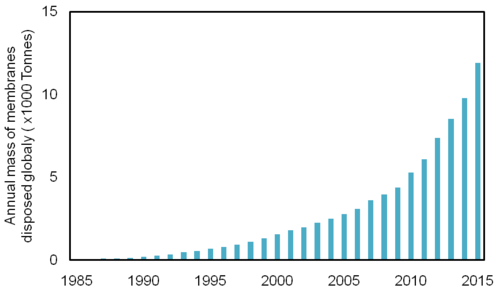Membrane Waste Challenge
Over the last two decades, there has been a 4 fold increase in the number of reverse osmosis (RO) desalination plants, and a 10 fold increase in capacity, with over 10,000 installations of various sizes currently online around the world. In Australia alone, the total RO capacity has risen from less than 100 ML.d⁻¹ in 1990 to nearly 3000 ML.d⁻¹ in 2012[1]. The size of these RO plants has also increased significantly, now exceeding 500,000 m³.d⁻¹ in many parts of the world. In Australia again, six large municipal sea water desalination plantsplus over a hundred commercial plants of various sizes are accounted for. Plant expansion is largely attributable to population growth, while decreased process energy costs and improved membrane performance remain critical contributing factors[2][3].
Notwithstanding the constantly growing need to secure water production, the desalination industry still faces the challenge of improving its environmental sustainability[4][5]. Although the large amount of energy needed to pressurise the feed water during RO desalination is the primary environmental concern, the disposal of old RO modules is emerging as a critical issue to be addressed. So far, used RO modules are considered as waste and are generally discarded to municipal landfills, with only limited disposal alternatives proposed to RO users.
Given the range of pre-treated water qualities and their associated operating conditions, it is estimated that an average of 100 of the 8” modules are generally needed to produce each mega litre per day of water. Based on an average of 13.5 kg per 8” module, the use of a basic single pass system, and a mean membrane life of 6 years, the inventory of the current plants worldwide allows the estimation of the total mass of modules to be disposed annually (Figure 1-1). The steady increase in the mass of disposed membranes, reaching 12,000 tonnes.yr⁻¹ globally by 2015, clearly indicates the magnitude of this disposal problem. In Australia, the current growth in the industry has resulted in an estimated 800 tonnes.yr⁻¹ of used membranes to be disposed by 2015.
These calculations assume a constant rate of desalination plant construction and expansion; however, that is proving to not be the case. In Australia, the large plants, which can produce up to 440,000 m³.d⁻¹, were all planned and constructed during a time of extreme drought. However, due to recent rainfall, political and budget concerns, a number of the plants have recently entered standby modes of varying degrees. While this may decrease the number of modules to be continually replaced and disposed of, it does pose an interesting challenge for the membranes stored at the plant. While temporary membrane storage is possible, little investigation into long term mothballing has been completed, and it is generally assumed that membrane performance and quality will decrease during extended storage. If an option besides landfill disposal can be proposed, then it will provide an alternative use for these membranes.
References
- ↑ Global Water Intelligence, 2012. DesalData.com online database. Global Water Intelligence. Available from www.desaldata.com
- ↑ Peñate, B., García-rodríguez, L., 2012. Current trends and future prospects in the design of seawater reverse osmosis desalination technology. Desalination 284, 1–8
- ↑ Schrotter, J., Rapenne, S., Leparc, J., Remize, P., Casas, S., 2010. Current and Emerging Developments in Desalination with Reverse Osmosis Membrane Systems. Water Research Center of Veolia
- ↑ Mezher, T., Fath, H., Abbas, Z., Khaled, A., 2011. Techno-economic assessment and environmental impacts of desalination technologies. Desalination 266, 263–273
- ↑ Roberts, D., Johnston, E., Knott, N., 2010. Impacts of desalination plant discharges on the marine environment: A critical review of published studies. Water research 44, 5117–28
